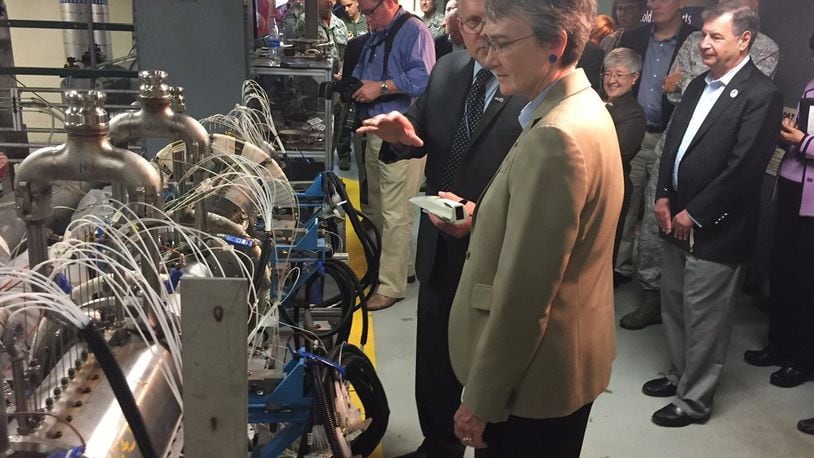The newly appointed top civilian leader participated in Corona Top, a gathering of top Air Force leaders who convene at Wright-Patterson Air Force Base in late June every year to strategize and debate key issues the service branch confronts.
“My view of base realignment and closure is that a threat needs to drive strategy, strategy drives force posture, and force posture should drive infrastructure,” said Wilson. “What we have for bases should support the mission for warfighting and that will really be the focus.”
BRAC is highly watched in the region because of the estimated $4.3 billion economic impact of Wright-Patterson Air Force Base, the largest single work site in Ohio with about 27,000 employees.
“The Air Force and all the services will be very clear about what really matters, and what matters is the mission and those kinds of things are going to make more of a difference,” Wilson told the newspaper. “Every community, or almost every community, supports the base that is near them and this community is no different.”
EXCLUSIVE: Top Air Force general says 'all programs are at risk' President Donald Trump submitted a defense budget that asked for a new round of base closures in 2021, and the Pentagon has estimated it has 20 percent more space than it needs.
Past rounds of base closures have saved $12 billion a year, according to a Pentagon estimate.
Even so, the House Armed Services Committee recently stripped the request out of the defense budget the panel sent to the lawmakers for a vote, noted Michael Gessel, Dayton Development Coalition vice president of federal programs.
While at Wright-Patterson, Wilson visited the 711th Human Performance Wing and the Air Force School of Aerospace Medicine, both of which were moved from Texas in the last BRAC round.
“There may be more opportunities for realignment like that if there’s another BRAC,” Wilson said.
Here are some of the other issues Wilson touched on in the interview:
The F-35
The Air Force Research Laboratory has the job of determining the cause of oxygen system problems that caused F-35 pilots based at Luke Air Force Base, Ariz., to report hypoxia-like systems that deprived aviators of oxygen in the cockpit.
“We’re going to get to the root cause of this and I’m confident that the engineers and scientists here at Wright-Patt” and others coming from around the nation will fix the problem, she said.
RELATED: Top AF leader: Wright-Patt looking for cause of F-35 problems Despite technical glitches in a years-long development, Wilson said she is committed to the jet.
“There’s nothing like it,” she said. “It is a complete revolution in the air war fight, so it’s an exceptional aircraft.”
Space Corps
Wilson said the Air Force has had the dominant role in space operations for decades and she rejected a call by some in Congress to create a separate Space Corps.
The Air Force has hiked spending on space capabilities about 20 percent this year, she said.
“Our adversaries know that we depend very heavily on space and we’re vulnerable there, so we have to take that seriously and prepare for that,” she said. “I think the Air Force is doing that.”
Wilson said a separate service branch would create unneeded bureaucracy.
“We’re moving forward to acquire better and faster, to train …space warfighters because we’re going to have to defend satellites we have in space to organize effectively and I don’t need more bureaucracy imposed by others,” she said. “I need to be able to move forward.”
Fighter pilot shortage
The Air Force has an acute shortage of fighter pilots, which reached 870 vacancies on active-duty rolls at the end of September. Overall, the Air Force, Air Force Reserve, and Air National Guard reported a shortage of more than 1,500 pilots as of June, numbers show.
RELATED: Air Force boost bonuses for fighter pilots to fill shortage in ranks The Air Force has offered a two-tiered pay system, offering between $10,000 to $35,000 a year for pilots who re-enlist.
Fighter pilots and drone operators would collect the highest bonuses.
Wilson, however, said money isn’t the only factor in the push to retain pilots in the cockpit.
“If we restore the readiness of the force so pilots know they can do the mission we’re asking them to do, that the jet is well-maintained, we’ve got the people to keep it in good shape, they’ve got the parts, they’ve got the gas and the flying time — that helps with retention in a big way,” she said.
“There’s no single solution to this,” she said. “We’ve got a task force focused on pilot retention and it’s going to be a hundred swings of the ax to chop this tree down.”
Sexual assault
The Air Force is adopting a program called Green Dot, which urges airmen to intervene to prevent sexual assault, Wilson said.
Saying everyone is responsible “for the culture in our squadron,” Wilson said, “We are going to implement that and try and see if we can reduce the incidents of sexual assault.”
About the Author
